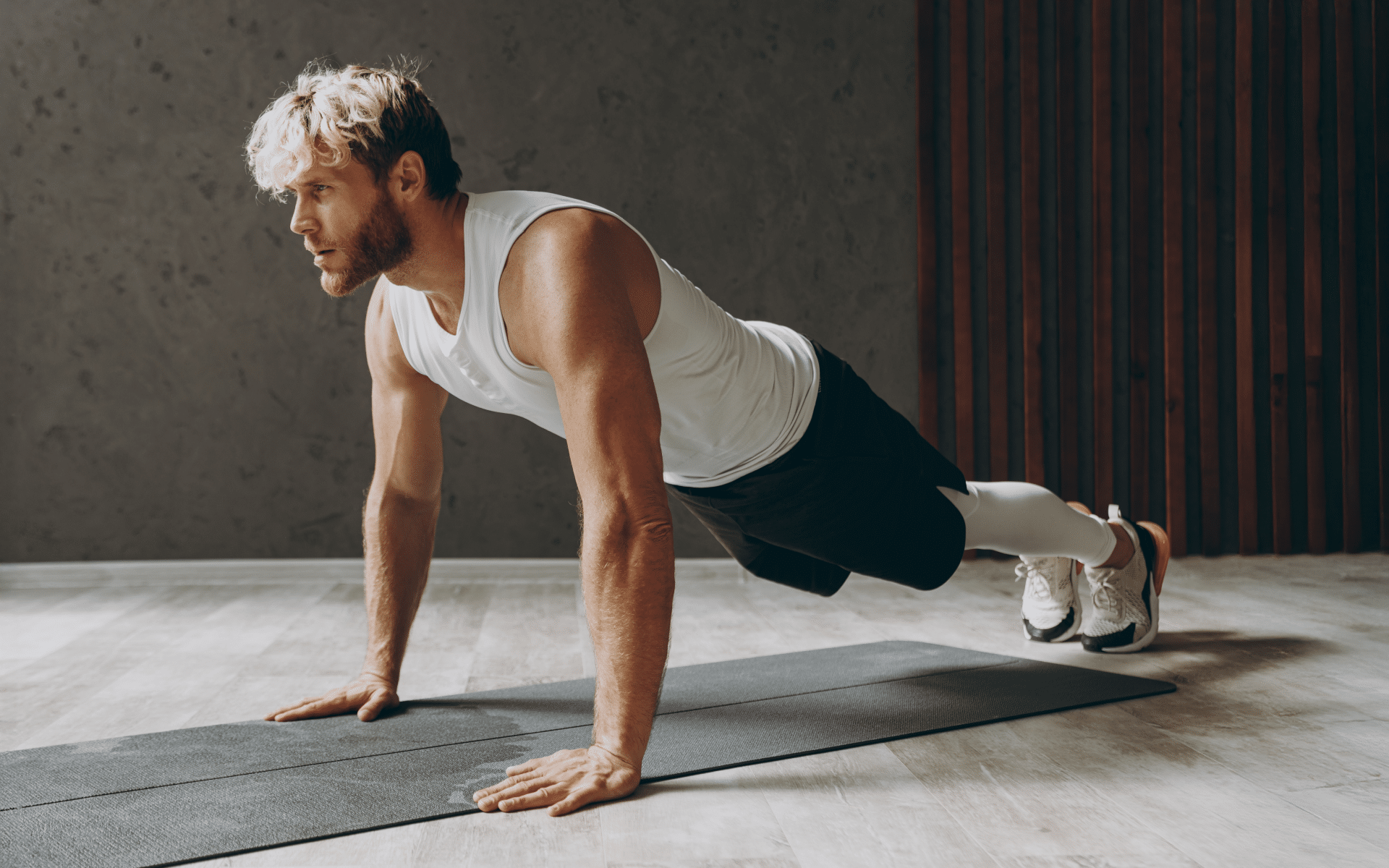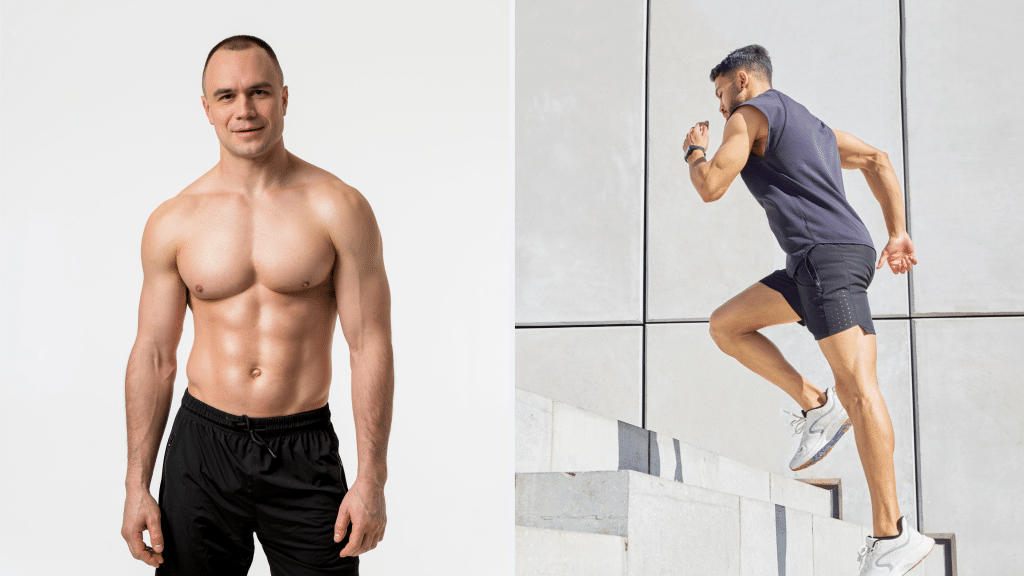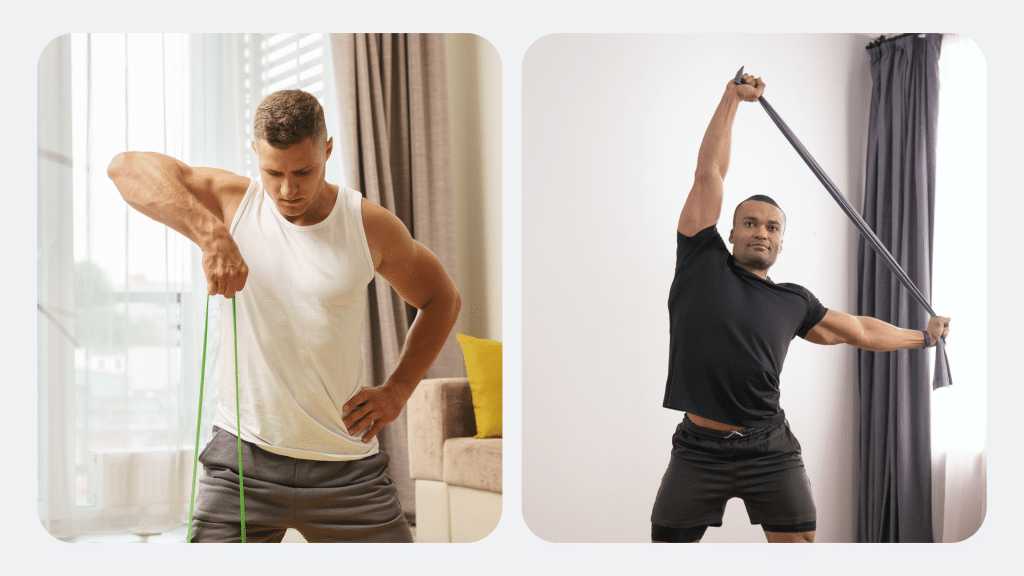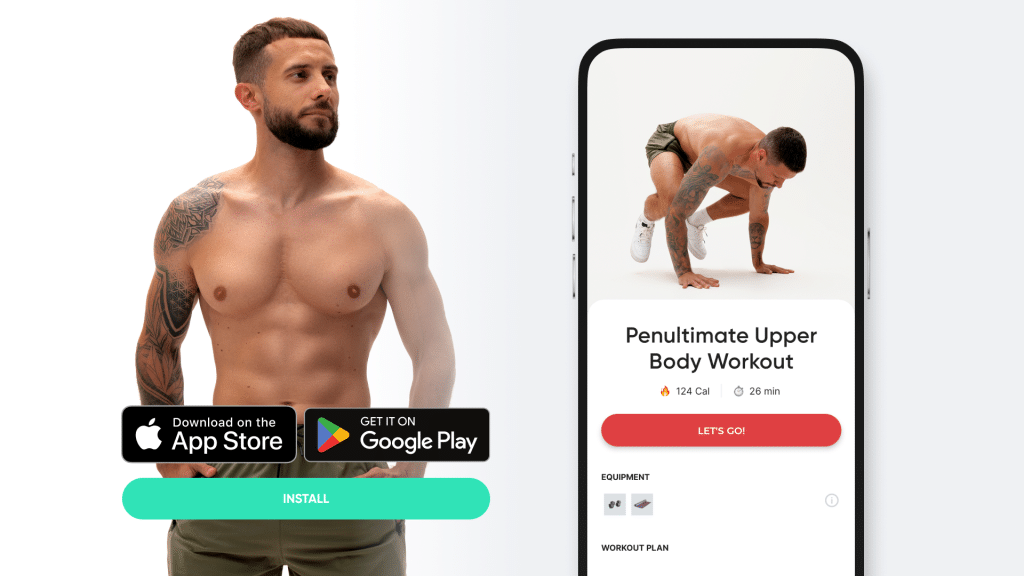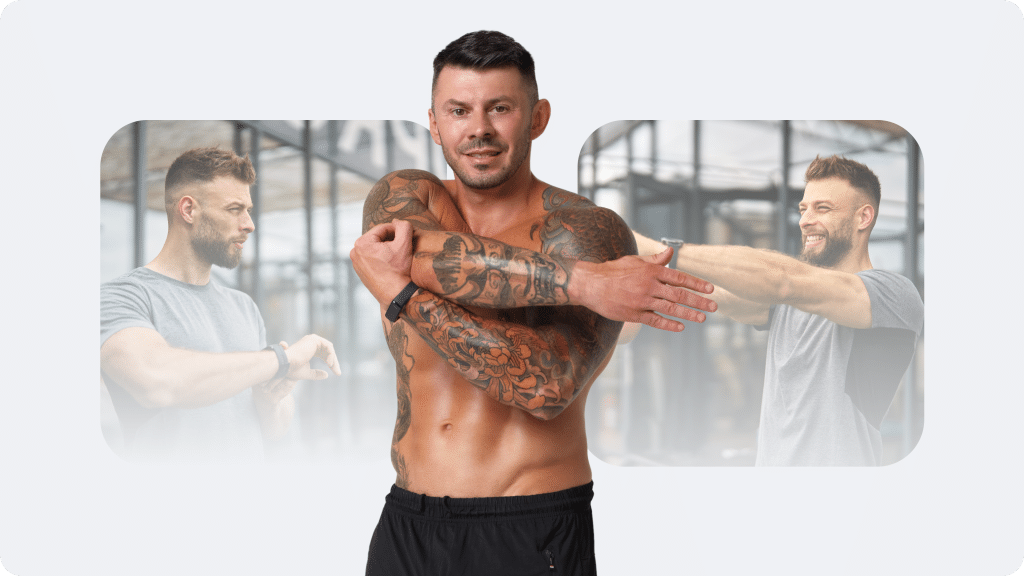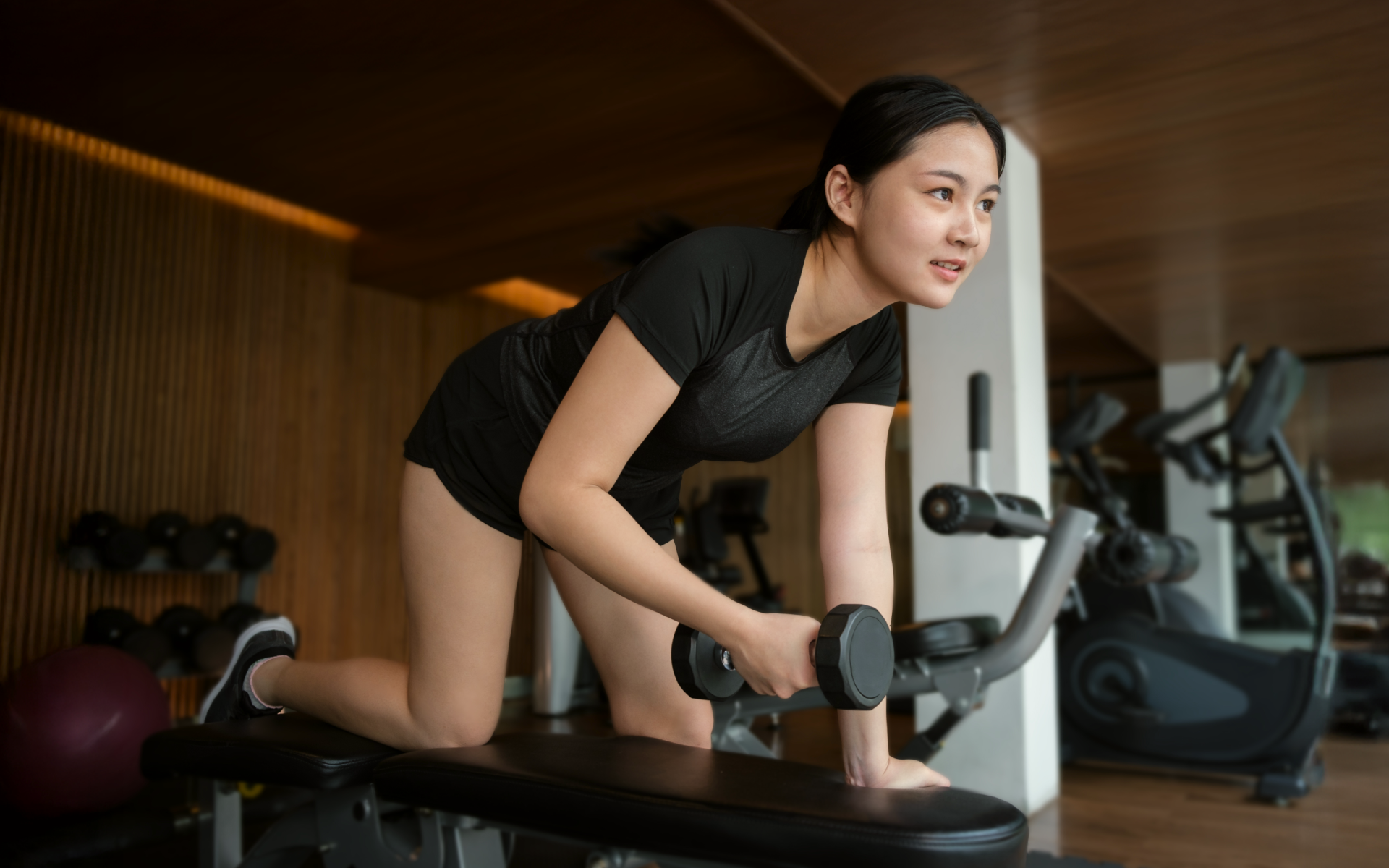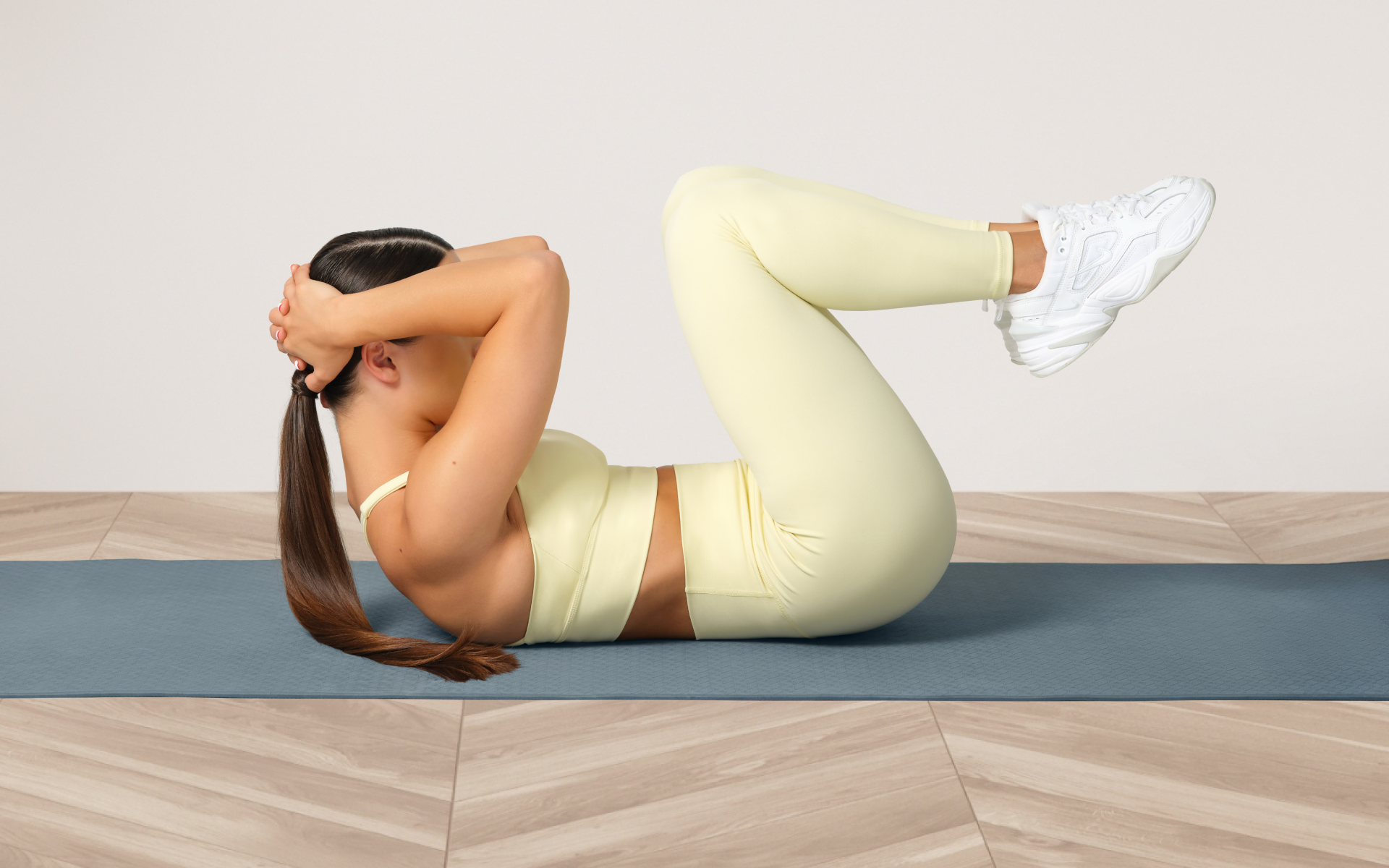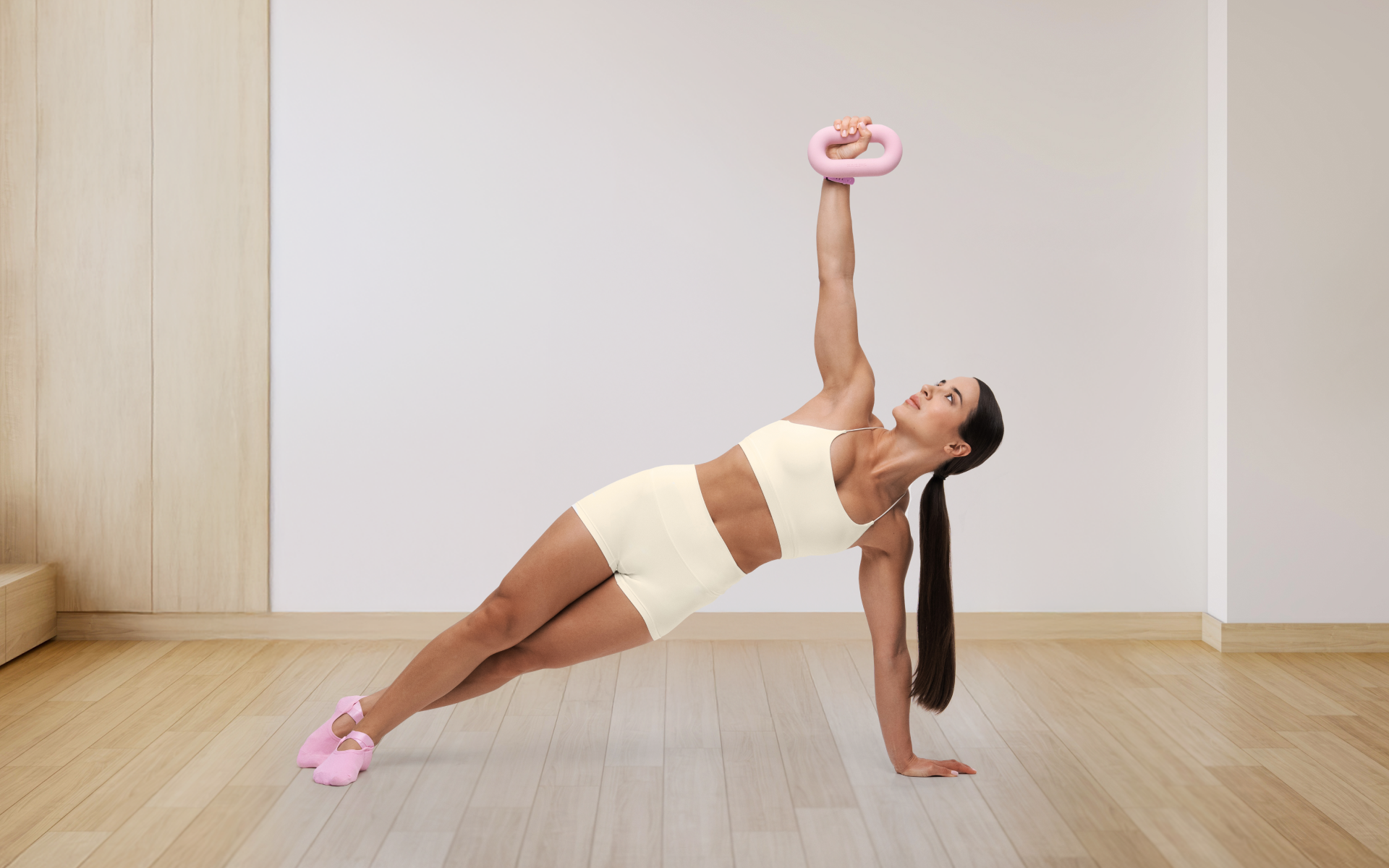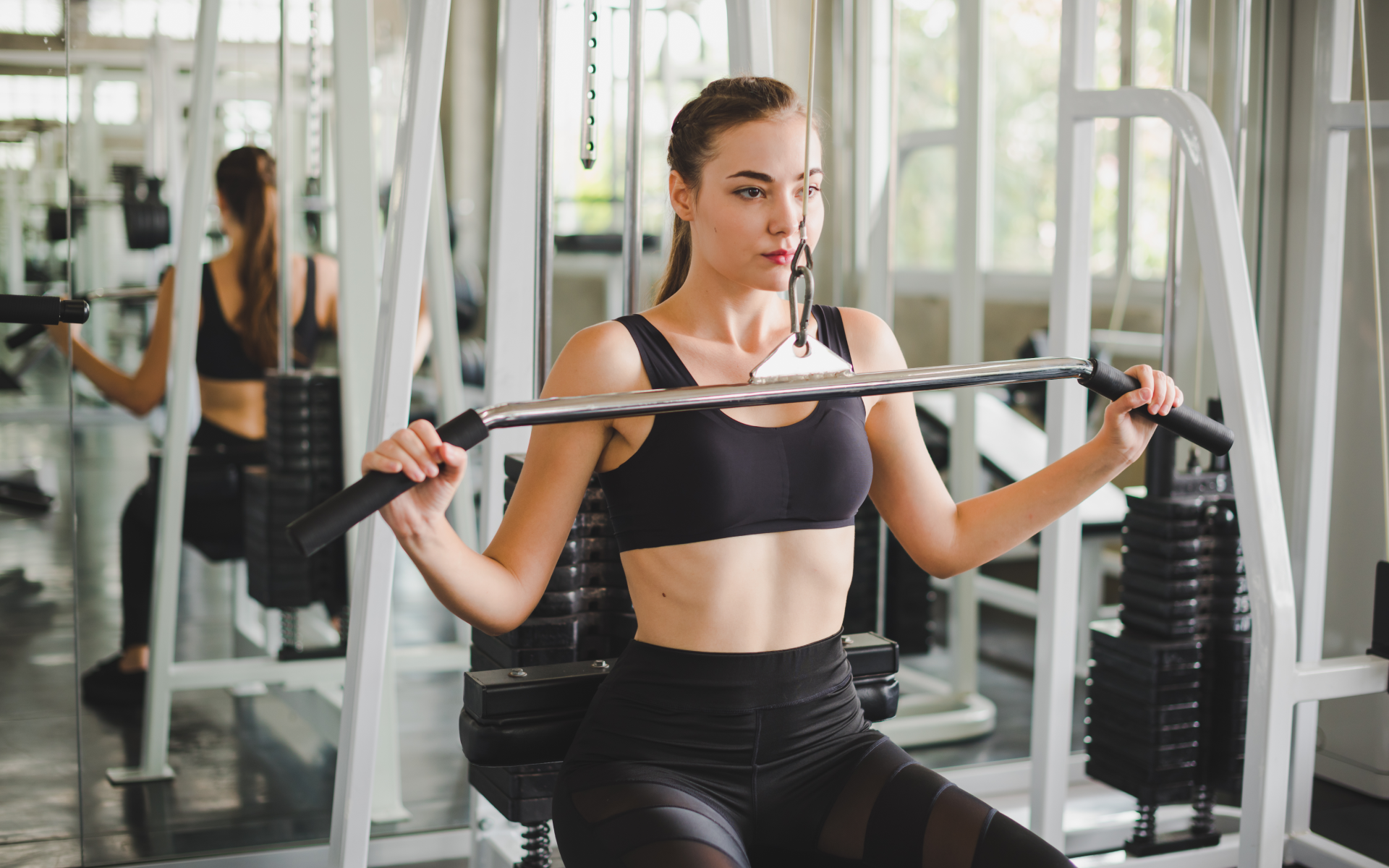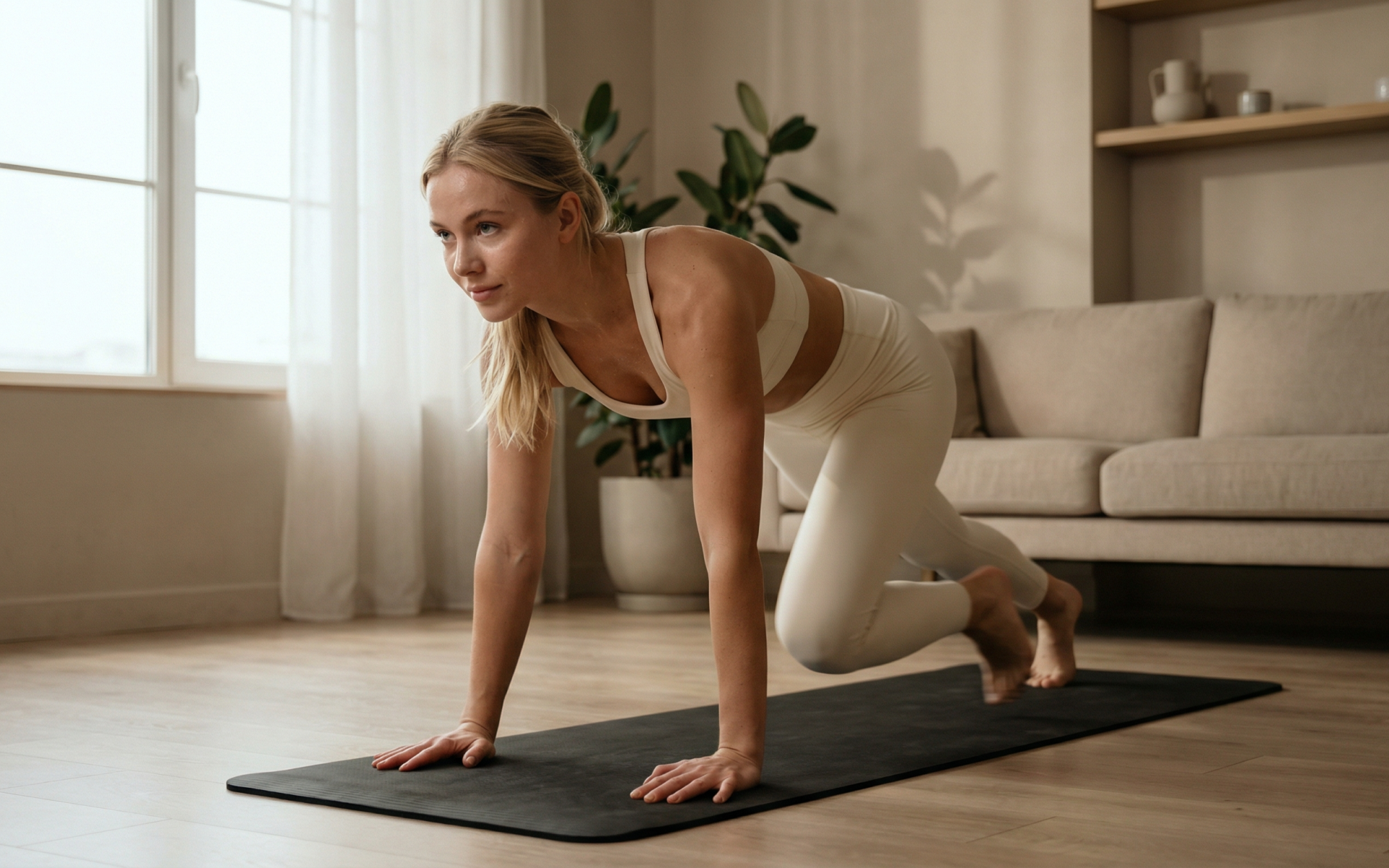Having a structured workout schedule keeps you on track. You don’t need to search for exercises every other day when you have divided your fitness routine into chunks. A body weight push workout is an integral routine to your weekly workout plan. It focuses on exercising the upper-body pushing muscles – mainly the chest, shoulders, and triceps (1).
Body weight workouts rely solely on the resistance of your own body, eliminating the need for external resistance like dumbbells, barbells, or machines. This approach builds strength and muscular endurance and offers flexibility, which allows you to perform these exercises virtually anywhere.
In this article, we’ll guide you through the foundations of a body weight push workout and offer tips to create an effective routine. Paired with a well-rounded strength routine that addresses the other major muscle groups, in addition to proper sleep and nutrition, this workout can be transformative, delivering impressive improvements in strength and endurance.
What Is an Example of a Good Body Weight Push Workout?
An effective body weight push workout engages all the primary pushing muscles in a cohesive sequence. This type of workout incorporates diverse exercises that make training both enjoyable and challenging, focusing on building both endurance and strength while enhancing explosive power throughout the upper body (3).
The best part? You don’t need any special equipment—just a sturdy chair or bench will do. Below, we’ve put together a body weight push workout designed to help you reach your fitness goals.
Warm-Up (5–10 minutes)
- Arm Circles: 30 seconds in each direction
- Shoulder Taps: 1 minute
- Wall Push-Ups: 1 minute (for shoulder and triceps activation)
- Dynamic Chest Stretch: 1 minute
Workout (3 sets per exercise)
This upper-body push workout focuses on building strength and endurance in your chest, shoulders, and triceps and will also provide a great secondary core workout. Complete each exercise for 3 sets, aiming to keep rest periods between 30 and 60 seconds to maintain intensity.
1. Decline Push-Ups
- Reps: 8–12
- Instructions: Place your feet on a raised surface (such as a step or chair) and get into a push-up position. Lower yourself toward the ground and push back up. This variation shifts more focus to your shoulders and upper chest.
- Modification: Lower the height of the surface or place your knees on the surface instead of your feet if you find this variation too challenging.
2. Push-Ups
- Reps: 10–15
- Instructions: Start in a high plank position with your hands shoulder-width apart. Lower your body until your chest nearly touches the ground, then push back up to the starting position. Keep your core tight and body in a straight line.
- Modification: Drop to your knees for an easier variation.
3. Pike Push-Ups
- Reps: 8–10
- Instructions: Start in a push-up position, then lift your hips to form an upside-down “V” shape. Bend your elbows to bring your head toward the ground, then push back up. This exercise targets your shoulders and upper chest.
- Modification: Lower the range of motion as needed or perform on an incline.
4. Plank to Push-Up
- Reps: 10–12
- Instructions: Start in a forearm plank position. Press up onto one hand at a time to come into a high plank, then lower back down one arm at a time. Alternate the arm you start with to keep it balanced.
- Modification: Perform the movement from your knees if full plank transitions are too difficult.
5. Tricep Dips (using the floor)
- Reps: 10–12
- Instructions: Sit on the floor with your hands placed just behind your hips, fingers facing forward. Lift your hips slightly off the floor and bend your elbows to lower your body, keeping them close to your sides. Push through your palms to return to the starting position.
- Modification: If needed, reduce your range of motion until you build more strength.
Cool-Down (5–10 minutes)
- Child’s Pose: 1 minute
- Chest Stretch: 1 minute on each side (standing arm against a wall)
- Triceps and Shoulder Stretch: 1 minute for each arm
This entire workout should take approximately 30-40 minutes. Perform 1-2 times per week in addition to workouts for the other major muscle groups, including upper-body pull and lower body. You can also adjust the sets and reps to your fitness level. You can increase the number when you feel you’re able to while maintaining correct form and pacing.
If you wish to free yourself from all the extra pounds that have been weighing you down for way too long, start using the BetterMe: Health Coaching app and overhaul your entire life!
What Are the Pushing Muscles?
The upper-body pushing muscles are those primarily engaged in “push” movements—exercises where you push weight away from your body or push your body away from a stationary object. These muscles are essential for various daily movements and play a key role in overall upper-body strength, stability, and power. The main pushing muscles in the upper body include:
- Chest (Pectorals)
The chest muscles, or pectorals, are among the most significant pushing muscles in the upper body. The pectorals consist of two muscles: the pectoralis major and pectoralis minor. These muscles power movements where your arms push forward or away from the body, such as in push-ups or bench presses. Strong pectorals contribute to upper-body strength, helping with tasks such as pushing heavy objects or supporting body weight in various exercises. - Front Shoulders (Anterior Deltoids)
The deltoid muscles, which are located around the shoulder, are divided into three heads: the anterior (front), lateral (side), and posterior (rear) deltoids. The anterior deltoid is the primary muscle that is involved in pushing exercises, helping lift the arms and stabilize shoulder movement. It works closely with the chest and triceps to support overhead and horizontal pressing movements, such as shoulder presses, pike push-ups, standard push-ups, or any other pushing exercise. - Triceps (Triceps Brachii)
The triceps are located on the back of the upper arm and consist of three heads: the long head, lateral head, and medial head. This muscle group is primarily responsible for extending the elbow, which is essential for any pushing movement. The triceps play a major role in exercises where the arm extends to push away from the body. Building tricep strength helps improve overall upper-body pushing power and stability.
Together, these muscles support a range of upper body movements, from pressing and pushing to lifting and stabilizing. Strengthening them not only enhances physical performance but also improves functional strength, benefiting daily activities that involve lifting, pushing, or holding weight. Integrating exercises that target these muscles into your routine can create a balanced and effective workout plan.
Read more: Best Pulling Exercises To Hit All Of Your Back Muscles
Why Is It Important to Do Both Push and Pull Exercises?
Incorporating both push and pull exercises into your workout routine is essential for developing balanced strength, preventing injury, and improving overall functionality. Push exercises focus on the muscles that contract when pushing weight away from the body, such as the chest, shoulders, and triceps, while pull exercises target the muscles that are involved in pulling weight toward the body, including the back, biceps, and forearms. Here’s why both types of exercises are crucial:
- Muscle Balance and Symmetry
Consistently training both push and pull muscles helps prevent muscle imbalances. Overworking one group while neglecting the other can lead to asymmetry, where certain muscles become stronger and tighter than their counterparts. This imbalance can negatively affect flexibility and overall body alignment. Balanced training ensures that opposing muscle groups—such as the chest and upper back, or the triceps and biceps—remain equally developed, which contributes to a well-proportioned physique and greater stability.
- Enhanced Functional Strength
Everyday activities require a combination of pushing and pulling movements, whether pushing open a door, lifting a box, or carrying groceries. By training both push and pull muscles, you develop functional strength that translates into real-world tasks, which makes daily movements easier and more efficient. This balanced approach also improves athletic performance, allowing for more powerful, coordinated movements.
- Injury Prevention
Focusing on both push and pull exercises reduces the likelihood of overuse injuries. Overdeveloping the push muscles, for example, while neglecting the back can place excess stress on the shoulders, leading to joint pain and poor scapulohumeral rhythm. Pull exercises help reinforce the stabilizing muscles around joints, which creates a balanced structure that supports safe movement patterns. This approach protects vulnerable areas, particularly the shoulders and lower back, from strain.
- Optimal Range of Motion
Balanced training between push and pull muscles supports a healthy range of motion in the joints. Overemphasizing one muscle group can create tightness and restrict mobility, particularly in areas such as the chest and shoulders. By incorporating both push and pull exercises, you maintain flexibility and allow joints to move freely, which is essential for safe and effective exercise performance.
In summary, balancing push and pull exercises fosters a stronger, more resilient body. It ensures muscle symmetry, promotes improved postural control, enhances functional strength, prevents injuries, and supports joint health, which makes it a vital aspect of any comprehensive fitness routine.
What Are the Main Benefits of Body Weight Push Workouts?
Body weight push workouts provide a blend of strength, functionality, and convenience, which makes them a valuable component of any fitness plan. Their ability to build muscle endurance, stability, and lean muscle definition without equipment ensures that you can achieve and maintain upper-body strength no matter where you are. Here are some of the primary benefits of body weight push workouts:
- Improved Upper Body Strength and Endurance
Body weight push exercises such as push-ups, tricep dips, and pike push-ups build strength in the chest, shoulders, and triceps without the need for heavy equipment. These workouts enhance muscle endurance as well, which allows you to perform pushing movements over longer periods. - Enhanced Functional Fitness
Body weight push exercises mimic many real-life movements, such as pushing a door open or lifting an object overhead. Training with these exercises develops functional strength that translates directly to everyday activities. This makes body weight push workouts a practical choice for anyone who is looking to improve their overall physical functionality and ease of movement. - Convenience and Accessibility
One of the major benefits of body weight push workouts is they can be done anytime, anywhere, with no equipment. Whether you’re at home, traveling, or at the park, these exercises require minimal space and no special setup. This makes it easier to stick to a fitness routine, even with a busy schedule or limited access to a gym. - Joint and Core Stability
Many body weight push exercises, such as push-ups and plank variations, require core engagement to maintain balance and control. This strengthens the core muscles and enhances stability around the shoulders, elbows, and wrists. Over time, body weight push workouts help improve joint stability, which reduces the risk of injury and supports better alignment during other exercises. - Scalability and Versatility
Body weight push workouts are highly versatile and can be easily modified to suit any fitness level. Beginners can start with knee push-ups or incline push-ups, while advanced athletes can increase the challenge with decline push-ups or explosive plyometric variations. This adaptability makes body weight push workouts an excellent option for long-term progression, which allows you to continuously improve without needing additional equipment. - Enhanced Muscle Definition
Regularly practicing body weight push exercises contributes to lean muscle development in the chest, shoulders, and arms, which can lead to a more defined upper body. As these exercises require sustained muscle engagement, they help sculpt the upper body over time, which leads to noticeable changes in strength and appearance with consistent training paired with proper nutrition and recovery.
Read more: Do Push Ups Burn Fat: A Full-Body Exercise That Will Kick Your Weight Loss Game Into Beast Mode
How Often Should I Do Body Weight Push Workouts for Optimal Results?
If you’re using a workout split that trains upper-body push on its own day, it’s typically not recommended to perform more than two workouts for any specific movement in a single week. This will allow you to get the necessary balance of upper-body pull and lower-body workouts throughout the week too, while still allowing for active rest days.
Ultimately your training frequency for a muscle group or general movement pattern may differ depending on how you split your routine and how much volume and intensity you pack into each session. Those with lower volumes and/or lower intensities in each session can typically train more frequently as less muscle damage and central nervous system (CNS) fatigue occur per workout, while high-volume/high-intensity sessions need more rest between workouts.
In general, aim for 10-20 sets per major muscle group (upper-body push, upper-body pull, lower body) per week and take at least 48 hours of rest between workouts for a major muscle group.
Whether you’re a workout beast or just a beginner making your first foray into the world of fitness and dieting – BetterMe has a lot to offer to both newbies and experts! Install the app and experience the versatility first-hand!
7 Tips for an Effective Body Weight Push Workout
Whether you’re doing a body weight pull workout or a body weight push workout, you should pay attention to some guidelines. Adhering to these ensures you make the most of these exercises and don’t end up injuring yourself.
- Warm-up: Start with a dynamic warm-up to prepare your muscles and joints. Include movements such as arm circles and torso twists.
- Focus on your form: Maintain proper alignment, sequencing, and pacing to avoid injuries.
- Train different muscle groups daily: Be sure to equally train upper-body pull and lower-body to ensure a balanced training regimen. This will result in a decreased risk of injury and improved functionality.
- Vary the intensity and volume: If you do body weight exercises daily, adjusting the intensity and volume can help you rest properly. Avoid training to failure daily and reduce the number of reps or sets or do lighter workouts on certain days instead.
- Focus on breathing: Breathe out while pushing up and inhale while lowering. Proper breathing helps maintain endurance and control.
- Stay consistent: Add push workouts into your routine 1-2 times per week to see the best results.
- Track your progress: Keep a record of your workouts and progress to stay motivated and make adjustments as needed.
Implementing these tips can help you make your body weight workouts more effective.
The number of push-ups you should do in a single workout depends on your fitness level and your goals. If you’re designing a workout specific to upper-body pull or lower body, there’s no need to perform any push-ups in your workout because it won’t be applicable to your goals for that workout. Assuming you’re designing a workout for which you’d like to include upper-body push exercises, you should treat push-ups like any other compound exercise. Start off simple, focusing on proper form with low volume and modifications as necessary. Build up your volume, intensity, and variation difficulty as you become stronger, assuming you can do so with proper form and without pain. From there, determine if you’re aiming to improve strength, hypertrophy, or endurance to accurately designate intensity and volume. Body weight exercises can be progressed using a variety of factors including increasing volume (sets and reps), decreasing rest time, adding in holds or slow eccentrics to increase time under tension, and modifying leverage and angles to make the exercise more challenging. Depending on your goals, you may modify one or multiple of these factors as you progress in your training. Push-ups can contribute to building a strong upper body, particularly for beginners and those working with limited equipment. Push-ups are a compound movement, which means they engage multiple muscle groups simultaneously—primarily the chest, shoulders, and triceps, with additional support from the core and stabilizing muscles in the upper back. By focusing on these key pushing muscles, push-ups can effectively develop strength and endurance in the upper body. However, while push-ups offer substantial benefits, a sole reliance on them has limitations. Over time, your muscles may adapt to the movement, and you might hit a plateau in strength gains. In addition, push-ups mainly target the “pushing” muscles and don’t engage the “pulling” muscles, such as the back and biceps, which are essential for balanced strength and injury prevention. To optimize upper-body development, consider incorporating push-up variations (such as decline push-ups, plyometric push-ups, and diamond push-ups) to increase the challenge. Adding complementary pulling exercises (such as rows or pull-ups) will create a balanced routine, which ensures well-rounded muscle growth and stability across the entire upper body. In short, push-ups can build a strong foundation, but for comprehensive upper-body strength, they are best supplemented with additional exercises. Incline push-ups, decline push-ups, pike push-ups, diamond push-ups, and dumbbell shoulder presses are some push workout variations that cover different muscle groups.Frequently Asked Questions
How many push-ups should I do in a single workout?
How can I increase the difficulty of body weight push exercises?
Can push-ups alone build a strong upper body?
What are some push workout variations to target different muscle groups?
The Bottom Line
Incorporating body weight push workouts into your fitness routine is an effective, accessible way to build upper-body strength, endurance, and functional fitness. By targeting key pushing muscles such as the chest, shoulders, and triceps, these exercises promote balanced muscle development and greater joint stability—both of which are essential for performance and injury prevention.
The versatility of body weight push exercises allows you to modify and progress your workouts based on your fitness level, while the convenience of requiring no equipment means you can train anywhere at any time. To achieve optimal results, you should aim for a balanced approach that includes both push and pull exercises, ensuring overall muscular symmetry and enhancing functional movement in your daily life. With dedication, proper technique, and a focus on progression, body weight push workouts can deliver substantial strength gains and contribute to a well-rounded fitness journey.
DISCLAIMER:
This article is intended for general informational purposes only and does not serve to address individual circumstances. It is not a substitute for professional advice or help and should not be relied on for making any kind of decision-making. Any action taken as a direct or indirect result of the information in this article is entirely at your own risk and is your sole responsibility.
BetterMe, its content staff, and its medical advisors accept no responsibility for inaccuracies, errors, misstatements, inconsistencies, or omissions and specifically disclaim any liability, loss or risk, personal, professional or otherwise, which may be incurred as a consequence, directly or indirectly, of the use and/or application of any content.
You should always seek the advice of your physician or other qualified health provider with any questions you may have regarding a medical condition or your specific situation. Never disregard professional medical advice or delay seeking it because of BetterMe content. If you suspect or think you may have a medical emergency, call your doctor.
SOURCES:
- No Time to Lift? Designing Time-Efficient Training Programs for Strength and Hypertrophy: A Narrative Review (2021, pmc.ncbi.nlm.nih.gov)
- Bodyweight Training for Muscular Strength & Endurance (2022, researchgate.net)
- Explosive exercises in sports training: A critical review (2007, researchgate.net)
- Effect of the push-up exercise at different palmar width on muscle activities (2016, pmc.ncbi.nlm.nih.gov)
- SHOULDER KINEMATICS DURING THE PUSH-UP PLUS EXERCISE (2011, pmc.ncbi.nlm.nih.gov)
- ACE Study Identifies Best Triceps Exercises (n.d., acefitness.org)
- Influence of bench angle on upper extremity muscular activation during bench press exercise (2015, pubmed.ncbi.nlm.nih.gov)
- Exploring the Science of Ballistic Training (2024, ripletic.com)
- Muscle Activation during Push-Ups with Different Suspension Training Systems (2014, pmc.ncbi.nlm.nih.gov)
- Anatomy, Thorax, Pectoralis Major Major (2023, ncbi.nlm.nih.gov)
- Pectoralis Minor Muscle (2012, sciencedirect.com)
- Triceps brachii (n.d., physio-pedia.com)
- Deltoid muscle contribution to shoulder flexion and abduction strength: an experimental approach (2021, sciencedirect.com)
- Effects of Different Between Test Rest Intervals in Reproducibility of the 10-Repetition Maximum Load Test: A Pilot Study with Recreationally Resistance Trained Men (2019, pmc.ncbi.nlm.nih.gov)
- Muscle Up! Evidence-based Solutions for Maximizing Muscle Growth (2014, acefitness.org)
- Synergistic effect of bodyweight resistance exercise and protein supplementation on skeletal muscle in sarcopenic or dynapenic older adults (2019, onlinelibrary.wiley.com)
- Core-Muscle Training and Neuromuscular Control of the Lower Limb and Trunk (2019, meridian.allenpress.com)
- Is core stability a risk factor for lower extremity injuries in an athletic population? A systematic review (2018, sciencedirect.com)
- Acute Effects of Dynamic Stretching on Muscle Flexibility and Performance: An Analysis of the Current Literature (2017, link.springer.com)
- Overtraining: What It Is, Symptoms, and Recovery (2021, hss.edu)
- The Bodyweight Squat: A Movement Screen for the Squat Pattern (2009, journals.lww.com)
